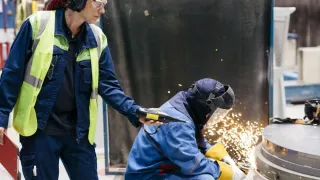Finnish Institute of Occupational Health media release 16 May 2023
Air impurities pose a threat to employees’ health. Often, exposure measurements will only concern one working day or work shift. However, impurities and exposure to them will often vary based on factors such as the nature of work and the worked materials.
The RASEM project studied the variety of impurities over time and in different locations in the work environment. The project developed a wireless network of sensors, with results complemented by moving robot cars and drone flights.
The Finnish Institute of Occupational Health participated in the international research project by testing the developed measurement systems at Finnish workplaces.
Measurements facilitate the prevention of exposure
“The sensor networks and the complementary robots allow identifying problematic areas where there are high levels of impurities. Employee exposure can be reduced by decreasing working time spent in these areas or by means such as increasing targeted ventilation,” says researcher Mikko Poikkimäki from the Finnish Institute of Occupational Health.
In addition, employees can be better instructed in personal protective measures if they need to work in areas with a higher than average exposure risk.
The measurements provided data on impurities over a long period of time, which provides a better overall understanding about exposure conditions at workplaces. Nonetheless, the data does not allow assessing employees’ direct exposure to impurities. In order to be able to assess exposure, employee location would need to be linked with data from the sensor network.
“Locating devices carried by employees could help solve this problem,” says Mikko Poikkimäki.
Robots and sensors still need other complementary measurement methods
Sensors for monitoring air quality are currently available for only a few of the exposure agents that are of interest from the perspective of occupational hygiene. At the same time, possible cross-sensitivity of the sensors to various compounds poses challenges to interpretation of the data.
That is why the results alone cannot be directly utilised, but rather they require extensive examination of the environment. There are still also challenges in the devices’ usability. The sensors must be maintained, cleaned and calibrated regularly as well as changed, as necessary. Possible safety risks posed by the moving robots must also be still examined.
“It is important to continue the research. In the future, sensor networks can be used for planning risk management and employee orientation, but before that we must first develop sufficiently reliable measurement methods,” says Tuula Liukkonen, Leading Specialist for the Finnish Institute of Occupational Health.
The Robot-assisted Environmental Monitoring for Air Quality Assessment (RASEM) research project
- The project developed a air quality monitoring system based on sensor networks and robots in order to assess air quality in industrial work environments.
- The studied locations included the car deck of a ship, a hot rolling mill and office premises into which manufacturing emissions enter occasionally.
- This was a collaborative Saf€ra project, with the German Bundesanstalt für Materialforschung und -prüfung (BAM) acting as the main responsible party. The Swedish Örebro University also participated in the project in addition to the Finnish Institute of Occupational Health. The study is funded by the Finnish Work Environment Fund, FIOH and BAM.
- Final report of the project (in Finnish): Robottiavusteinen työympäristöjen ilman laadun mittausjärjestelmä (RASEM) (julkari.fi)
Further information
- Mikko Poikkimäki, Researcher, Finnish Institute of Occupational Health, +358 50 576 7583, mikko.poikkimaki [at] ttl.fi (mikko[dot]poikkimaki[at]ttl[dot]fi)
- Tuula Liukkonen, Leading Specialist, Finnish Institute of Occupational Health, +358 40 556 7737, tuula.liukkonen [at] ttl.fi (tuula[dot]liukkonen[at]ttl[dot]fi)



